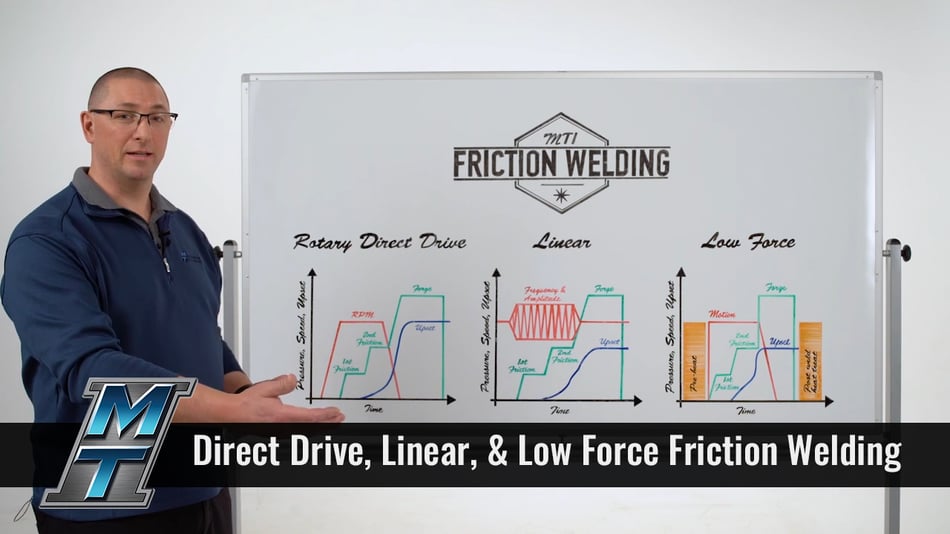
Take a look at the room around you – it’s likely filled with objects of all shapes and sizes. Some may be round, others may be flat. Some may be big, others may be small.
The same goes for the parts and components that help cars drive, planes fly and boats sail.
So it should be no surprise that friction welding isn’t a one-size-fits-all technology– its machines and processes need to match the parts they’re joining, whether they can fit in the palm of your hand or could fill an entire room.
In this episode of Whiteboard Wednesday, we’re taking a look at MTI’s three most popular forms of friction welding. We’ll highlight the differences of each one… but also explain how they all stem from our legacy joining technology.
ROTARY DIRECT DRIVE FRICTION WELDING
In our last episode of Whiteboard Wednesday, we examined the three most popular types of Rotary Friction Welding: Direct Drive, Inertia and Hybrid.
This time, we’re still using Rotary Direct Drive as our foundation, but we’ll explain how it stacks up against Linear Friction Welding and our newest joining technology, Low Force Friction Welding.

As a refresher from our last episode, with Direct Drive Friction Welding, we attach a round component on the spindle side and a stationary component on the tailstock side.
We then rotate it up to a certain speed, and then bring it up to a different load profile in order to generate the energy to complete the weld.
Our second load allows for some upsetting, which ultimately leads to us squeezing out all the hot material in the forge phase.
We do have the option of extending the second friction phase to add more heat to the component, allowing us to control the cooling rate to avoid forming martensite for a hardenable material. However, in doing this, more upset is generated.
LINEAR FRICTION WELDING
The same thought process applies when we consider another one of MTI’s popular joining technologies, Linear Friction Welding.
With Linear Friction Welding, we use an oscillatory motion instead of the rotary motion.

The oscillatory motion expands our possibilities for joining parts… and it also happens to be a major benefit for Aerospace companies.
Here’s why.

This is a bladed disk, otherwise known as a blisk. It’s a critical jet engine part... but because of its unusual shape, it cannot be joined with most traditional welding technologies.
However, using Linear Friction Welding, we can oscillate between the blisk’s relatively odd-shaped airfoils and the disk, achieving a quality, repeatable weld.
In addition to achieving more complex welds, Linear Friction Welding also offers the same benefits of Inertia Friction Welding, such as:
- Bringing on a full forge load from the beginning
- Shortening the weld time, creating a metallurgical advantage
Both Rotary Direct Drive and Linear Friction Welding allow us to adjust the energy input so we can generate a weld profile that is attractive for the application we are welding.
We will then extend that same thought process to our newest joining technology, Low Force Friction Welding.
LOW FORCE FRICTION WELDING
In Low Force Friction Welding, we use an external energy source to add heat before any motion begins in the welding process – this is known as the pre-heat phase.

Low Force Friction Welding can be used in either Rotary or Linear friction welding. Here is an example of two solid bars welded with Low Force linear motion, but this same geometry could also be welded with Low Force rotary motion.

This adaptable technology offers a list of benefits, including:
- Faster cycle times, thanks to heating the component before welding
- Reduced machine size
- Smooth flash and low upset
- Larger part range
- Expanded capabilities
Plus, we can include a post-heat phase where we add energy in order to control the heating rate, again to avoid forming martensite on a hardenable material. This helps get the fatigue performance we need, and with Low Force we can do it with a faster cycle time at a lower cost compared to traditional Direct Drive friction welding.
BRINGING IT ALL TOGETHER
Whether your project would best benefit from Rotary, Linear or Low Force Friction Welding, MTI can design and build a custom machine to suit your needs and application.
Still not sure which technology would be best for your part?
Get in touch with us today to speak to our knowledgeable sales engineers, who will walk you through the process from start to finish.
 MTI UK
MTI UK  FWT
FWT